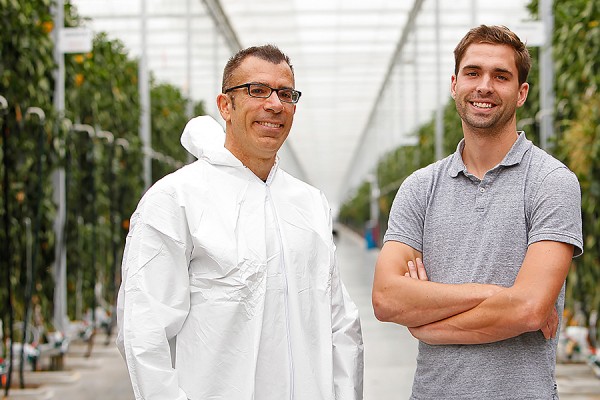 UWindsor professor Rupp Carriveau and greenhouse operations engineer Lucas Semple are pictured at an Under Sun Acres greenhouse in Leamington, Ont. The university has teamed with the produce grower to examine the feasibility of a solar energy system.
UWindsor professor Rupp Carriveau and greenhouse operations engineer Lucas Semple are pictured at an Under Sun Acres greenhouse in Leamington, Ont. The university has teamed with the produce grower to examine the feasibility of a solar energy system.
University of Windsor researchers have teamed with local produce growers to improve greenhouse energy efficiency and decrease operating costs.
The two-year project led by professor Rupp Carriveau, director of UWindsor’s Environmental Energy Institute and co-director of the Turbulence and Energy Lab, is examining the technical and economic feasibility of a solar energy system designed to reduce dependency on carbon-based fuels for heating and grid-connected power for electricity.
“We're focusing on energy from the sun,” says Dr. Carriveau, who is working on the project with David Ting, co-director of the Turbulence and Energy Laboratory. “The advantage here is that we can offset some of the dependence on natural gas, which of course we know has a carbon footprint and has a notable water footprint as well.”
The innovative system harvests solar energy to bolster both greenhouse heating and power requirements. Carriveau says a defining system feature is its ability to store the solar energy for use in times when the sun is not shining. Advanced chemical batteries will store the electricity and water tanks that contain a strategic phase change material (PCM) store the heat.
“The use of PCMs in thermal energy storage is still experimental, but it’s exciting,” Carriveau says. “It improves the performance of the entire system by enabling the thermal batteries (water tanks) to store more heat in the same footprint.”
Funded by the Greenhouse Renewable Energy Technologies R&D Initiative, the project is one of only three projects approved in Ontario — and the only one led by a university. UWindsor received $98,000 to conduct the comprehensive techno-economic study.
Chris Del Greco, owner of Under Sun Acres and Rising Sun Acres Greenhouses, is leading the industrial side of the project alongside Lucas Semple, the greenhouse operations engineer and a UWindsor engineering alumnus. The greenhouses produce sweet bell peppers and are located in Leamington, Ont., which is home to North America’s largest concentration of greenhouses.
“From crop production and pest management to heating demands, climate control, ventilation, energy curtains and right into our irrigation recirculation system and packing house, we are always trying to stay ahead and streamline to be more efficient,” Semple says. “Making this whole process more efficient from an energy perspective and from a labour perspective is very important for the whole community.”
The project is now entering final design stages. More design detail will be added through collaboration with other industrial partners, including Green Sun Rising, Baird Architects and Engineers, and BDK Engineering.
“Behind-the-meter solutions like ours enable growers to reduce their dependency on grid-connected energy,” says Carriveau. “This can be welcomed by grid operators who often look for novel ways to meet increasing energy demand without major public infrastructure investments. There are so many possibilities here, including the potential of linking multiple operations in a greenhouse microgrid. It’s exciting work — we’re thrilled to be doing it.”
—Kristie Pearce
